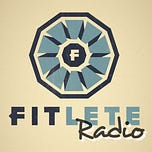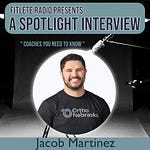We get to know Jane Metcalf in this Trainer Spotlight episode of FITLETE Radio.
GEORGE: Introduce yourself and tell us a little about what you do and your background.
Hi, my name is Jane. I'm a certified personal trainer and I am the owner of Move Well Feel Well personal training services. So personal training is actually my second career. I started off working in politics actually for almost a decade now. I worked in several state legislatures and I am so glad to not be working in politics anymore. Let me just say that and I'm so, so glad to be able to help my clients and do some meaningful work as a personal trainer. So I love working with perimenopausal moms who have older kids. They have a little bit more time freedom, but they have some injuries, whether it's from delivery or it's just the aches and pains that we pick up along the way. So I love helping them be able to learn how to lift weights around their injuries, eventually through their injuries, eventually getting them to their pain-free place. And then they thrive and they bloom and it is an absolute joy to be alongside them for that journey. So that's my business. That's my goal. And then I'm online and I am in person. And so I just realized that I love doing both. I love helping people in different areas, from different states, from different time zones. And I also love being in the community and helping my one-on-one people in person because it's super rewarding to be able to be there to watch a person lift some heavy weight, to watch a mom lift some heavy weight that she never thought she could lift and then feel wildly proud of herself when she can do it. She feels good, tired, but it's like a good tired, not a pain tired.
GEORGE: Tell me a funny or interesting story about yourself that helps us get to know you as a human.
when I was a new trainer, I wasn't even like a regular gym goer. I was a new trainer in the gym. I didn't know how to use most of the machines, because when I started working out I'd use kettlebells and dumbbells and TRX straps, but not really the machines because they intimidated me. And so I was on the pull-up, the assisted pull-up machine for the first time, and if you've never been on that machine, you basically, it has like two steps, and then it has a pad, and then it has overhead bars where you can place your hands, and so you step up onto the pad, put your knees on the pad, and then in terms of the weight, you mark how much weight you want the machine to take off so you can actually do a pull-up. So, like, I think I marked like 120, right? And I did not know how to get off of that thing, and in hindsight, of course I should have just climbed back off one knee at a time, but when I was done, I just let go, and the weight stack, along with me, on that pad, we all came crashing down. I wasn't hurt, but you can bet that everyone in the gym turned and looked at me, and I was like, hey, it's me. What's worse is I was a trainer there. Like, I, if anyone should know how to use these machines, it's the trainers, but I was new, and I'm chalking it up as if I do the dumb things, then my clients will not.
GEORGE: What strategies do you use to attract and retain clients in your personal training business?
I've recorded this like three times because I have so much on this and let me just say that I don't know any trainer who goes into personal training to become like super wealthy. It's honestly we go into it to help people be able to lift weights and get stronger and all the benefits that come with exercise that we've fallen in love with. So the business uh learning business strategies have been such a huge opportunity for growth. So here are several of the things that I've learned that I implement and I'm working on to improve. Number one I have absolutely put money into a business coach and I go to a business conference a fitness business conference of some sort once a year. Like those are just built into my budget because being in the room from with other trainers with other people who have gone through the process who have these tools and tricks and tips has been wildly helpful and has saved me so much time and I am absolutely willing to spend money to save time. Number two I've realized that I have to give a lot before I ask and so one of the things the movement maestro says Shante Coleman she's like you have to give and give and give before you ask and you have to give things of value. So I try and do for sure one freebie every quarter but I'm trying to get that down to like once a month where it's something of actual value so it's not just like a you know hook to get people's emails like legit try and provide something helpful and then draw those people in. Number three I think the hardest part for me is at some point you just have to sell and so I have a sale of some sort planned in every quarter and even if the sale has not gone well I've come to realize it's an opportunity to figure out how to say things better do things better provide something better and then typically people will sign up because you're presenting an opportunity before them and so sometimes it's like you just have to keep showing up and be willing to be messy and post even when you think no one is watching because sometimes no one's engaging but people are watching and then when they come to the point where finally they're like you know what I need help I trust you please help me you're there and it's an easy sell. Nothing is as easy in business though that I'm finding.
GEORGE: What is your process for assessing a new client's fitness level and addressing their goals?
I love this. We finally get to talk about training. So I strongly, strongly believe in having a client-led experience. So I don't, like, my philosophy is I don't force anybody to work out. I'm here to complement your workout journey, to provide guidance, but I'm not making you do anything. You're choosing to do so and that's something that's really important to me that they choose to work out. It's not that I'm making them work out. Number two, most of my clients, because they're moms who have never lifted weight before, the strength training world can be very intimidating. And the last thing I want to do is make them feel worse about a workout. So they're probably coming to me with pain. They're coming to me with anxiety. They're probably feeling down on themselves if they're getting injured. Like, why do I keep getting injured? And so I want to break through all of that. So one of the first things I do is just communicate. Today we're gonna just check in on some muscles. I'm gonna teach you how to foam roll, how to warm up. And there are no wrong answers. So I might say, hey, can you feel this muscle? And if you can't, that's okay. We're gonna be very curious about your body. There's no right or wrong. We're just gonna play and see what happens. Are you up for playing? And they'll usually, at that point, they start to feel a little bit more comfortable. And the second thing I say is, hey, you may always interrupt me if something I'm asking you makes you feel pain or it makes you feel uncomfortable. I will never be upset if you interrupt me and cut me off because something is not okay for you. So please, please do that. And then what I do is I guide them through the movement assessment. So I used to like call it a movement assessment, but an assessment can be very anxiety-inducing. So what I do is after I teach them how to foam roll and warm up, and I just go off the common things. We foam roll the quads, we foam roll the lats, and then usually the calves. I start there. And then I move on to just a simple workout, and I check for three things. Core strength, pelvic floor core, right? Glute strength, and then back strength. And to me, that's my hierarchy of things I'm gonna check because that's the common areas where most people are like lacking in. And I just guide them through a few glute bridges. I move them through a movement pattern of pelvic tilts, right? Can they feel their pelvic floor? And then can they feel their glutes when they start to squat? So I just have them do a gentle, easy workout, and that tells me a lot more of what's happening versus doing like an assessment per se. So...
GEORGE: What certifications do you hold, and how do you stay updated on the latest fitness trends and research?
At this point, after training for seven years, I feel like I have so many certificates. I'm not going to remember them all, but the ones that I feel are like the most notable, I love, love, love Barbell Rehab. I think if you're working with people who have injuries, Barbell Rehab is incredible, and it's an organization that pairs physical therapists with personal trainers, and it addresses a question like, where can we help a client when they have pain? And so it's been just a wonderful organization to connect with physical therapists, and then just knowing that they can confidently hand off their clients to us. We won't drive them into the ground, but we'll help their recovery process and help them get stronger. I have my postpartum certificate from Girls Gone Strong, and that one has been very helpful in not just helping new moms or moms who just had babies to helping my older moms, because a lot of the issues that they have stem back to deliveries, even if their kids are like 10, 15 years old. So I think the other one I have is my NASM's corrective exercise, and I have my NASM certificate as well. The other thing I do is I actually have subscriptions to a few people in the industry who are holding, doing their research in sports medicine, in biomechanics, and so I subscribe to their monthly like research reviews, and then I try and read those, keep up to date, and just constantly look at what's coming out from those qualified sources, not just from whatever's on social media.
GEORGE: How do you envision your personal training business evolving in the next few years?
So as a new trainer I started off in a gym and after that I you know started my own business and I was in the online space and I still am in the online space and I believe in it and I think it's such a wonderful opportunity to help more people which I love like I love being able to help people from different states and you know virtually and even in the online programming space where you know you create their workouts you do all those things the other thing I've come to realize is I love being in person and I need both for for me I know some people are either fully online or they're fully in person but for me my happy place is both so I definitely will I'm in the process of contracting out some space so that I can train and still have my business because I don't want to be a hired employee I want to still have move well feel well personal training services and so my happy place is going to be a hybrid of half in person doing the very real tangible work and then half online with programming for clients I don't I know some coaches are completely online and they're doing like no virtual time and I know it's possible I don't think that actually works for me in the sense that like I don't want to not see how people move because we're dealing with injuries and I want to just give them a workout set and be like good luck so I think for me that one-on-one face time is important so that I know that I'm giving them the best workout for their body for their injuries and so I don't ever fully see myself like completely not seeing clients on some level and I love love love the online space I think that has been such a huge tool to expand our reach to help more people and not let like location be a barrier to it.
GEORGE: What do you think are the biggest challenges currently facing the fitness & personal training industry?
I think at this point it's like the oversaturation of bad information. There's just too much information. I love social media, don't get me wrong. I think it's an amazing tool to connect us with people from other parts of the world. I have learned things from TikTok and Instagram that I never knew. I took like taking the information to my doctor and I'm like, hey I learned this online and she's like, yeah that's absolutely true. So I think social media can be a very positive place. So I'm not saying this is like a negative like naysayer. I just think also that the space is so easy for people to yell misinformation and sometimes the louder someone is yelling they sound believable. So I think one of the challenges for us is to continually cut through that noise and point back to evidence-based strategies of what works. And so the misinformation. The other thing that I think is a challenge is it's almost too easy to enter into training and I wish, I know this is unpopular opinion, I wish we were more regulated in some sense because I feel like it's easy for like bad seeds to get in and there's no or there's like small repercussions for them versus just having a regulatory body that makes us more professional I feel. So other industries have to go through so much to get you know their license and certification and I think it would actually hurt, it would help, I'm sorry, it would help us to have some of those same like steps to legitimize us as a more professional industry.
Want more Jane Metcalf in your life? You can find’em here:













